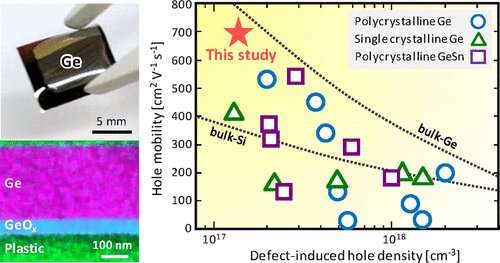Record-breaking hole mobility heralds a flexible future for electronics

Technologists envisage an electronically interconnected future that will depend on cheap, lightweight, flexible devices. Efforts to optimize the semiconductor materials needed for these electronic devices are therefore necessary. Researchers from the University of Tsukuba have reported a record-breaking germanium (Ge) thin film on a plastic substrate that offers flexibility without compromising performance. Their findings are published in ACS Applied Electronic Materials.
Ge is a popular semiconductor for use in transistors because it has high charge carrier mobility (charge carrier refers to the electrons and electron holes that move through the material). Ge can also be processed at the relatively low temperature of ~500 degrees Celsius and has a low Young’s modulus, which means it is a softer alternative to commonly used materials such as silicon.
Ge thin films can be grown using the solid-phase crystallization technique. These thin films are polycrystalline, meaning they are made up of many Ge crystals. In general, larger crystals lead to greater carrier mobilities because bigger crystals form fewer grain boundaries that obstruct the current. Recent increases in grain size have therefore led to effective Ge thin-film transistors on rigid substrates such as glass.
However, many of the plastic substrates used to introduce flexibility are not resistant to temperature above 400 degrees Celsius, which makes it difficult to grow high quality crystals with appropriate carrier mobility.
Now, the researchers have used a polyimide film that can withstand temperatures up to 500 degrees Celsius. This allowed post-annealing treatment of the films, meaning crystal quality was not compromised for flexibility.
“We grew a GeOx layer directly on the flexible polyimide, then the Ge film on top of that,” explains study lead author Professor Kaoru Toko. “Oxygen that diffused into the Ge from the GeOx layer helped to achieve large crystals. We found that the Ge crystallinity was influenced by both the thickness of the GeOx layer and the temperature at which the Ge layer was grown.”
In this study, the largest Ge crystals observed were approximately 13 µm in diameter and grown at 375 degrees Celsius on a 100-nm-thick GeOx layer. The large grain size resulted in the film having a hole mobility of 690 cm2 V−1 s−1, which is the highest value reported to date for a semiconductor on an insulating substrate.
“Our record-breaking film is a significant step forward for transistor technology,” says Professor Toko. “Its high performance, combined with its flexibility, affordability, and portability, make it perfectly suited to the development of new flexible devices such as wearable electronics to support future digital initiatives such as the internet of things.”
Toshifumi Imajo et al, Record-High Hole Mobility Germanium on Flexible Plastic with Controlled Interfacial Reaction, ACS Applied Electronic Materials (2021). DOI: 10.1021/acsaelm.1c00997
Citation:
Record-breaking hole mobility heralds a flexible future for electronics (2021, December 23)
retrieved 23 December 2021
from https://techxplore.com/news/2021-12-record-breaking-hole-mobility-heralds-flexible.html
This document is subject to copyright. Apart from any fair dealing for the purpose of private study or research, no
part may be reproduced without the written permission. The content is provided for information purposes only.
For all the latest Technology News Click Here
For the latest news and updates, follow us on Google News.
